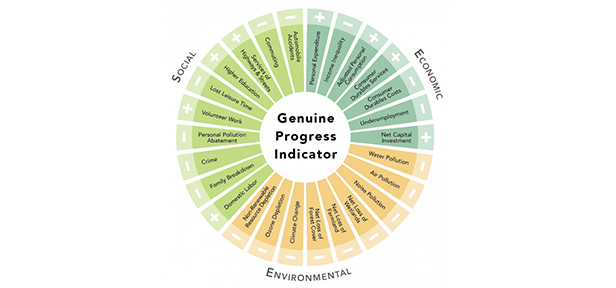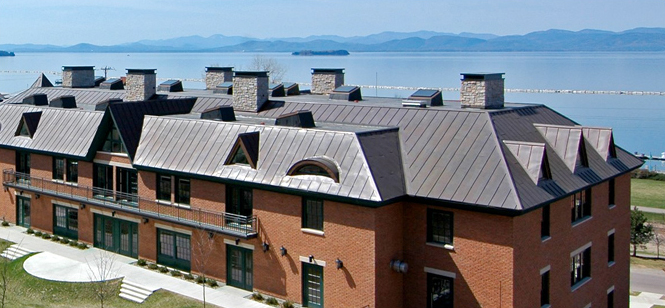A genuine economy creates more benefits than costs. Benefits are relatively easy to count. Just add up all the stuff that people buy and sell every day. But what do economists miss when they only count goods and services bought and sold in the marketplace? What’s missed when the only value of our time is what we get paid to work? What about the myriad of costs that never get charged, such as the costs from depleting and polluting the environment? And how are both costs and benefits from an economy distributed among its citizens? Enter: the Genuine Progress Indicator.
All growth is not created equal
Before the 1940s, there were no economy-wide indicators to help guide economic policy. Policy makers in the U.S. and around the world were flying blind during the Great Depression. The economic advisers to President Franklin Roosevelt literally counted freight cars to answer the question: Is the economy growing or shrinking? With nations gearing up for the second world war, they also needed an economic gauge to transition in and out of military production. The Gross Domestic Product was created to answer these basic questions about the size, transitions, ups and downs of an economy.
World leaders today are almost singularly obsessed with GDP as a gauge of standard of living. Is it growing? How fast? How much GDP is there per person? But more and more people are asking: What kind of growth, and for whom? Even one of the chief architects of the GDP, Nobel Prize–winning economist Simon Kuznets, warned in 1962: “Distinctions must be kept in mind between quantity and quality of growth, between its costs and return, and between the short and the long term. Goals for more growth should specify more growth of what and for what.”
In 1968, Senator Robert Kennedy popularized the critique and laid out a road map for new indicators. In a speech at the University of Kansas, he lamented that the GDP “does not include the beauty of our poetry or the strength of our marriages, the intelligence of our public debate or the integrity of our public officials. It measures neither our wit nor our courage, neither our wisdom nor our learning, neither our compassion nor our devotion to our country, it measures everything in short, except that which makes life worthwhile.”
Towards a more genuine indicator of progress
Soon thereafter, in 1972, Yale economists William Nordhaus and James Tobin introduced the Measure of Economic Welfare to ask: If an economy grows by depleting assets, is that true growth? In the 1980s, World Bank–economist Herman Daly and theologian John Cobb developed the Index of Sustainable Economic Welfare, a composite index that further expanded the scope of social and environmental factors, and broadened the question to: If the benefits of growth don’t outweigh the costs, is the economy delivering sustainable well-being? And through an interdisciplinary effort led by the think tank Redefining Progress in the 1990s, the Genuine Progress Indicator was born.
The GPI of today takes into account income inequality and non-market benefits such as spending time volunteering or parenting one’s kids. It also deducts negative effects, including depletion of natural assets such as forests and wetlands, and pollution of our air, land and water. While the GDP per person in the U.S. has grown many times over since Kuznet’s warning and Kennedy’s critique, the U.S. GPI peaked in the late 1970s and has been flat ever since.
US GPI Graph (from Redefining Progress)
States Lead the Way on GPI
The aftermath of the Great Recession has brought a renewed interest in alternative indicators of economic and broader well-being. While the U.S. and other nations have seen steady GDP growth since the financial crisis of 2007–2008, more and more people have been left behind. U.S. income inequality has hit levels not seen since the 1920s, and the growing costs of climate change, water pollution and fossil-fuel dependence have renewed Kennedy’s prophetic call for new metrics of progress.
While one can hope for congressional leadership on new metrics of progress, a growing number of states have decided not to wait. Maryland was the first state to adopt the GPI in 2010, when Governor Martin O’Malley launched an initiative to present the state’s GPI through an online tool. And in 2012, the State of Vermont passed GPI into law. In 2013 O’Malley hosted a GPI summit, which was attended by representatives from 20 states, and now Oregon and Washington are moving in this direction. In 2014, the University of Vermont held a practitioners’ summit, where analysts from across the country came to learn the best practices for measuring GPI.
And why stop with just dollars and cents? While the GPI was designed to put all values into economic terms and compare with the GDP, there are even broader indicators that address quality of life. The World Values Survey, for example, asks people more generally about their life satisfaction, and more specifically about their needs, wants and aspirations. What these metrics strive for in the broadest sense is to understand how the economy contributes to quality of life, and what trade-offs exist between material well-being and the interconnected health of our communities, societies and environment. These broader indicators of “happiness” also show a leveling off in recent decades, again, in spite of a growing economy.
American homes are bigger than ever, we have more luxuries and conveniences than any generation in history, we have witnessed the fullness of a consumer society. But who has been left behind? Has consumption translated to well-being? What would the future hold in a post-consumer society?






